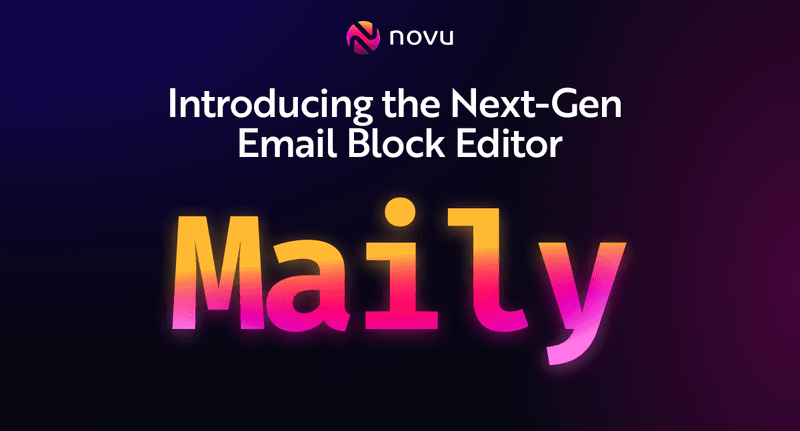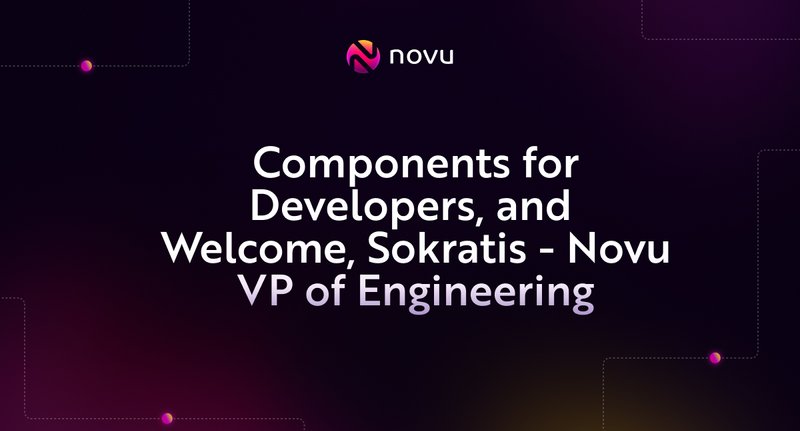The future of Novu
Explore what's next for Novu, the open-source notification infrastructure, including its innovative UI, code-first workflows, and seamless integration for delivering top-notch notification experiences.

One might think that Novu began almost three years ago with the first commit (ee3d8e for the geeks in the room). In reality, the dream of Novu started much earlier when, in a previous business, Tomer and I struggled to build—for the third time—yet another notification system.
We shared our vision with the community on dev.to, and the feedback was immediate. Turns out, we were far from alone in facing this issue. And since then, we’ve heard similar experiences from thousands of developers. We committed to ourselves and the community to embark on a journey to build the first open-source notification infrastructure. And this is where our journey began.
What does it even mean?
Since the beginning, Novu as we know it today has evolved from listening to direct feedback, implementing changes, and then listening to more feedback. One thing has been obvious: notifications are a huge pain point for our customers and users. However, we realized that something in our approach to solving this issue was not working.
One of the first questions a company needs to answer is, “Who are we building this product for?” In our world, engineers are tasked with building/implementing and then maintaining such a system. Still, notifications serve the end-user experience and improve the business’s ability to communicate effectively with its end users and customers. After all, notifications are core to the engagement and stickiness engine that drives many of these organizations’ business models.
And it was a question harder to answer than initially anticipated.
What we have learned
While building Novu with our community and observing the competition, it became clear that a UI-only solution was not up to the challenge. On one side, it was too limiting for the complex use cases our customers faced, and building in the required flexibility into this approach meant real trade-offs would need to be made (such as WYSIWYG editor limitations, which are extremely common issues in multiple industries). Sure, we could cater to many customer use cases. But, internally, we were very unhappy with the resulting Developer Experience (DX), and the friction they encountered when working to send their first production notification. Ultimately, what started as a straightforward pathway had become a difficult one that offered a sub-par experience for technical and non-technical users alike.
This is where the idea of Novu v2 was born. Considering thousands (I’m not kidding on this!) of feature requests and feedback notes, we knew we needed to do more than continue to piecemeal a product together that “kind of” worked for some number of specific use cases. We wanted to build on a stronger foundation.
We knew that this foundation had to be limitless. No matter the complexity of the use case or ever-changing demands and requirements, this new foundation should provide you with a way to achieve it and still leave a smile on your face.
Ultimately, we want a product that provides the ease of buying a packaged product, but with the power and extensibility of something you built in-house.
What’s next for Novu
We released the first v2 alpha in early July, which provided a solid foundation that immediately allowed our customers to:
- Create richer content experiences using the frameworks of their choice
- Build a complete notification design system while still providing control to non-technical team members
- Easily manage and hydrate data for your notifications
- Integrate more easily with third-party vendors and existing developer tools they are already using
And this was just the beginning. The feedback we received was clear: while extremely powerful, the UI-driven workflow management is a necessary companion to the entirely code-based engine we released with v2 alpha.
Flexible no-code UI back-ended by the all-code Novu Framework
With this learning in mind, we are on a mission to build a new and wholly re-designed UI that exposes much of the @novu/framework power but in a package that’s accessible to everyone and with the ability to punch out to the all-code Novu Framework, flexible enough to accomplish any use case, no matter how demanding or customized.
Our goal is simple: build an opinionated system with maximum usability while enabling groundbreaking flexibility to accomplish nearly any use case possible.
The best <Inbox /> experience available
One of our most demanded notification channels is the Inbox for in-app notifications. When delivering messages over outbound channels such as Email and Push, end-users are more than ever engaging with our Inbox component to see everything they missed, in context, while using the app. Another exciting learning was seeing how end-users use our Inbox as their personal to-do list within the tools they are using.
We are committed to building a richer, more immersive user experience while providing the best developer experience (DX) for developers looking to integrate Novu within their applications, and with the ability to customize the Inbox component to any style.
Truly yours,
Tomer and Dima




